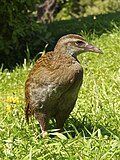Superregnum: Eukaryota
Regnum: Animalia
Subregnum: Eumetazoa
Cladus: Bilateria
Cladus: Nephrozoa
Superphylum: Deuterostomia
Phylum: Chordata
Cladus: Craniata
Subphylum: Vertebrata
Infraphylum: Gnathostomata
Superclassis: Tetrapoda
Cladus: Reptiliomorpha
Cladus: Amniota
Classis: Reptilia
Cladus: Eureptilia
Cladus: Romeriida
Subclassis: Diapsida
Cladus: Sauria
Infraclassis: Archosauromorpha
Cladus: Crurotarsi
Divisio: Archosauria
Subsectio: Ornithodira
Subtaxon: Dinosauromorpha
Cladus: Dinosauria
Ordo: Saurischia
Cladus: Theropoda
Cladus: Neotheropoda
Infraclassis: Aves
Cladus: Euavialae
Cladus: Avebrevicauda
Cladus: Pygostylia
Cladus: Ornithothoraces
Cladus: Euornithes
Cladus: Ornithuromorpha
Cladus: Ornithurae
Cladus: Carinatae
Parvclassis: Neornithes
Cohors: Neognathae
Ordo: Gruiformes
Familia: Rallidae
Genus: Gallirallus
Species (2): G. australis – G. calayanensis
Name
Gallirallus Lafresnaye, 1841
References
Lafresnaye 1841. Rev.Zool. 4 p.243
Vernacular names
suomi: Tyynenmerenluhtakanat
lietuvių: Vekos
Gallirallus is a genus of rails that live in the Australasian-Pacific region. The genus is characterised by an ability to colonise relatively small and isolated islands and thereafter to evolve flightless forms, many of which became extinct following Polynesian settlement.
Description
Many of the rails, including the well-known weka of New Zealand, are flightless or nearly so. Many of the resultant flightless island endemics became extinct after the arrival of humans, which hunted these birds for food, introduced novel predators like rats, dogs or pigs, and upset the local ecosystems. A common Polynesian name of these rails, mainly relatives of G. philippensis, is veka/weka (in English, this name is generally limited to Gallirallus australis).
On the other hand, Gallirallus species are (with the exception of the weka) notoriously retiring and shy birds with often drab coloration.
Living and recently extinct species
In the online list maintained by Frank Gill, Pamela Rasmussen and David Donsker on behalf of the International Ornithological Committee (IOC), the genus contains two species:[1]
| Image | Scientific name | Common Name | Distribution |
|---|---|---|---|
 |
Weka | Gallirallus australis | New Zealand |
| Calayan rail | Gallirallus calayanensis | Calayan Island in the Philippines. |
These species are placed by BirdLife International and IUCN in the separate genus Hypotaenidia but are still considered part of Gallirallus by The Clements Checklist of Birds of the World/eBird:
Okinawa rail, Gallirallus okinawae
Barred rail, Gallirallus torquatus
Pink-legged rail, Gallirallus insignis
Roviana rail, Gallirallus rovianae
Guam rail, Gallirallus owstoni - extinct in the wild (late 1980s)
Lord Howe woodhen, Gallirallus sylvestris
Buff-banded rail, Gallirallus philippensis
Dieffenbach's rail, Gallirallus dieffenbachii - extinct (mid-19th century)
Wake Island rail, Gallirallus wakensis - extinct (1945)
Tahiti rail, Gallirallus pacificus - extinct (late 18th - 19th century)
Species extinct before A.D. 1500
Illustration of an unidentified extinct species (possibly G. vekamatolu) from Vava'u, 1739
Nuku Hiva rail, Gallirallus epulare[2]
New Ireland rail, Gallirallus ernstmayri
Ua Huka rail, Gallirallus gracilitibia[2]
Niue rail, Gallirallus huiatua [3][4]
Tinian rail, Gallirallus pendiculentus
Aguiguan rail, Gallirallus pisonii
Mangaia rail, Gallirallus ripleyi[5]
Tahuata rail, Gallirallus roletti[2]
Tubuai rail, Gallirallus steadmani[6]
Huahine rail, Gallirallus storrsolsoni
Rota rail, Gallirallus temptatus
‘Eua rail, Gallirallus vekamatolu - possibly survived to the early 19th century[7][8]
Hiva Oa rail, ?Gallirallus sp.
Vava'u Rail, Gallirallus [Hypotaenidia] vavauensis Worthy & Burley 2020.[9]
References
Gill, Frank; Donsker, David; Rasmussen, Pamela, eds. (2020). "Flufftails, finfoots, rails, trumpeters, cranes, limpkin". IOC World Bird List Version 10.2. International Ornithologists' Union. Retrieved 7 August 2020.
Kirchman, Jeremy J.; Steadman, David. (2007). "New species of extinct rails (Aves: Rallidae) from archaeological sites in the Marquesas Islands, French Polynesia". Pacific Science. 61 (1): 145–163. doi:10.1353/psc.2007.0008. hdl:10125/22605. S2CID 86793953. Archived from the original on 2014-06-11.(subscription required)
"Gallirallus huiatua; holotype". Collections Online. Museum of New Zealand Te Papa Tongarewa. Retrieved 16 July 2010.
Steadman, David W.; Worthy, Trevor H.; Anderson, Atholl J.; Walter, Richard. (2000-06-01). "New species and records of birds from prehistoric sites on Niue, southwest Pacific". Wilson Bulletin. 112 (2): 165–186. doi:10.1676/0043-5643(2000)112[0165:NSAROB]2.0.CO;2. Archived from the original on 2007-05-24.(subscription required)
Steadman, D. W. (1986). "Two new species of rails (Aves: Rallidae) from Mangaia, Southern Cook Islands". Pacific Science. 40 (1): 27–43.
Worthy, Trevor H.; Bollt, Robert. (2011-01-01). "Prehistoric birds and bats from the Atiahara site, Tubuai, Austral Islands, East Polynesia". Pacific Science. 65 (1): 69–86. doi:10.2984/65.1.069. hdl:10125/23211. S2CID 54836563. Archived from the original on 2014-09-21.(subscription required)
A similar bird was found to live on nearby Vava‘u in 1793. Given that G. vekamatolu was flightless, this may just as well represent a related species.
Kirchman, J.J.; Steadman, D. W. (2005). "Rails (Aves: Rallidae: Gallirallus) from prehistoric sites in the Kingdom of Tonga, including description of a new species". Proceedings of the Biological Society of Washington. 118 (2): 465–477. doi:10.2988/0006-324x(2005)118[465:rargfp]2.0.co;2.
Worthy, Trevor H.; Burley, David V. (2020). "Prehistoric avifaunas from the Kingdom of Tonga". Zoological Journal of the Linnean Society. 189 (3): 998–1045. doi:10.1093/zoolinnean/zlz110.
Retrieved from "http://en.wikipedia.org/"
All text is available under the terms of the GNU Free Documentation License

